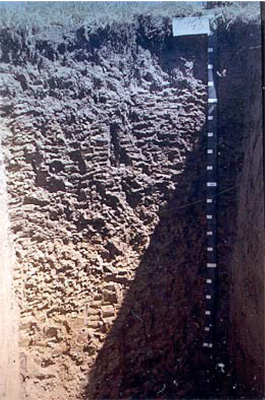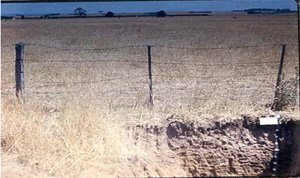OTR743
|
| OTR743 |  Melanic, Mesonatric, Black Sodosol | |
| Birregurra | |||
| Plain | |||
| Neogene Hanson Plain Sand, calcareous clay | |||
| Mid slope | |||
| 1% | |||
| South-easterly | |||
Horizon | Depth (cm) | Description | ||
A1 | 0–20 | Very dark brown (10YR2/2); fine sandy loam; moderate granular structure (2 mm); diffuse smooth boundary to: | ||
A2 | 20–38 | Very dark brown (10YR2/3); greyish brown (10YR5/2); when dry; sandy clay loam; some ironstone gravel; moderate fine (8 mm) subangular blocky structure; abrupt wavy boundary to: | ||
B21 | 38–60 | Very dark brown (10YR2/2); heavy clay; strong very fine (2 mm) angular blocky structure; very hard when dry consistence; diffuse smooth boundary to: | ||
B22 | 60–120 | Dark greyish brown (2–5YR4/2); heavy clay; strong coarse (35 mm) angular blocky structure with angular blocky fine (2 mm) secondary structure; hard when dry consistence; soft accumulations of calcium carbonate; gradual smooth boundary to: | ||
C1 | 120–180 | Mottled yellowish brown (10YR5/6) and dark grey (2.5YR4/0); heavy clay; strong angular blocky structure; soft accumulations of calcium carbonate; diffuse smooth boundary to: | ||
C2 | 180+ | Olive (5YR5/6) dark grey (2.5YR4/0) mottles; heavy clay; strong angular blocky structure. | ||
| Management considerations | ||||
| Strong texture contrast between the surface soil and the subsoil is prominent in this soil. This can have a major effect by reducing and/or redirecting the internal drainage and restricting root growth beyond the upper horizons. The acidic surface soils (topsoil) with a sandy loam texture may be due to the lack of base minerals and may or may not have organic matter (humose or peaty surfaces). This restricts the uptake of certain nutrients as well as intolerance for some plant species (due in part to the increasing mobilisation of aluminium and manganese). The sodic subsoils have poor structure (generally as coarse domed columns) resulting in dispersion (and subsequent clogging of pores), restricting water and gas movement through the subsoil. These soils are hardsetting and have limited opportunity for cultivation without further damage to soil structure. Alkaline subsoils are associated with a high nutrient capacity but result in an imbalance in nutrient availability (may be restrictive to certain plant species (eg. potatoes). Calcium carbonate nodules (segregations, soft and hard) are associated with these alkaline soils. | ||||
Analytical data
Site OTR743 | Sample depth | pH | EC | NaCl | Ex Ca | Ex Mg | Ex K | Ex Na | Ex Al | Ex acidity | FC (-10kPa) | PWP (-150kPa) | KS | FS | Z | C | |
Horizon | cm | H2O | CaCl2 | dS/m | % | cmolc/kg | cmolc/kg | cmolc/kg | cmolc/kg | mg/kg | cmolc/kg | % | % | % | % | % | % |
A1 | 0-10 | 5.0 | N/R | 0.072 | 0.008 | 1.7 | 2.0 | 0.3 | 0.3 | N/R | N/R | N/R | N/R | 24 | 42 | 9 | 18 |
A1 | 10-20 | 5.1 | N/R | 0.032 | 0.003 | N/R | N/R | N/R | N/R | N/R | N/R | N/R | N/R | N/R | N/R | N/R | N/R |
A2 | 20-30 | 5.4 | N/R | 0.025 | 0.003 | 0.7 | 1.2 | 0.1 | 0.2 | N/R | N/R | N/R | N/R | 32 | 45 | 9 | 12 |
B21 | 38-60 | 6.5 | N/R | 0.061 | 0.006 | 5.1 | 8.9 | 0.4 | 2.3 | N/R | N/R | N/R | N/R | 14 | 24 | 6 | 53 |
B22 | 90-120 | 8.7 | N/R | 0.540 | 0.037 | 8.7 | 17.6 | 0.4 | 6.3 | N/R | N/R | N/R | N/R | 15 | 23 | 3 | 53 |
C1ca | 150-180 | 8.5 | N/R | 0.030 | 0.054 | 6.5 | 14.0 | 0.3 | 5.9 | N/R | N/R | N/R | N/R | 14 | 31 | 8 | 46 |
C2 | 180-210 | 8.5 | N/R | 0.860 | 0.085 | 7.1 | 16.0 | 0.5 | 6.5 | N/R | N/R | N/R | N/R | 10 | 23 | 10 | 44 |



